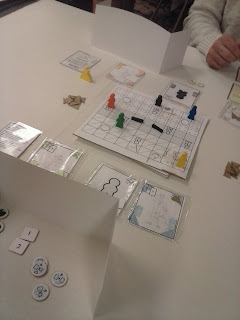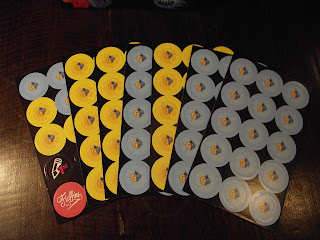 |
| Flag Dash Designer: Kirk Dennison Publisher: Piecekeeper Games |
Disclaimer
Back in October I went to the Madison Protospiel event where game designers meet up to play each other's games and provide feedback. It's a great event and I got some great feedback on several of my own games as well as had the opportunity to play a bunch of other awesome games being developed by other designers. One of those was a game called Capture! by Kirk Dennison. It was a fun little capture the flag game for two to four players. Fast forward four months and now Capture! has been further developed, had artwork completed, and undergone a name change. The newly named Flag Dash is now ready for Kickstarter and I'm fortunate enough to have the chance to review the finished prototype. So, is Flag Dash ready for the jump from Protospiel to production? Read on for my opinion.
 |
| Playing Capture! before it was renamed Flag Dash. |
Overview
In Flag Dash players are friends that have gotten back together after years of growing up to play their favorite childhood game; capture the flag. A familiar game and setting allows for simple, quick games, or alternate settings and special character abilities that the characters probably didn't have when they played as kids, add an extra level of fun.
 |
| Who wouldn't want to get together with their childhood friends for an afternoon of capture the flag!? |
 |
| Two teams consist of two players and three characters each. |
 |
| Just pick up that flag and run across the sidewalk! How hard can it be? |
Let me back up a little bit... The game board for Flag Dash is a 9x8 grid. A 2x9 'sidewalk' divides the board into two territories, one for each team. Each team is composed of three characters; two runners and one defender. In a four player game, each player controls one runner and shares control of the defender with their teammate (in two and three player games, players will control all three characters on teams with only one player). Pawns representing the runners and defenders are placed on the board in designated locations (or secretly in variant setups). Then a flag is placed in each territory. Depending on the setup, tunnel tokens (which let players move around the board quickly) and wall markers (which act as obstacles) are added to the board as well. Then each player receives a set of seven Action Cards and seven Priority Tokens.
 |
| Just starting a four-player game on the alternate playing field. |
Action Cards have symbols on them representing all the different possible Actions that can be taken: Move Forward, Left, Right, Backward; Repeat an Action, Push a Character (which causes them to drop a flag if they are carrying one), and Grab a Flag (which lets you pick up a team flag or grab an adjacent character's personal flag). Priority Tokens have a number from one to seven on them and also some additional benefits ranging from play a single card to play an additional card to play one card multiple times. Some priority tokens also award Boosts, which can be played on later turns for an extra movement. Each character also receives two personal mini flags in their color - if a character collects three mini flags from each opponent character it is an alternate win condition.
 |
| Action cards and priority tokens. |
At the beginning of the round each player chooses two action cards that they want to use this round, one for their first turn and one for their second turn. They also choose a priority token for each Action card that will decide turn order. Sometimes it's beneficial to use a lower priority to go first, but sometimes you want to wait and see how the other players' movements pan out and go last. Also, the further back in the turn order you choose to go the better your priority token benefit can be.
 |
| Play two actions and two priority tokens. |
Once all players have selected their two actions and priorities, each player simultaneously reveals just the priority token for their first action. Then these actions are resolved in turn order. Once everyone has completed their first action the process repeats for the second action. Players can choose to use the action on either their own pawn or their shared defender pawn, but can't control their partner's pawn or any opponents. The result is that many times the actions that you planned to take don't do exactly what you expected them to do because other characters have moved, you've been pushed, or a flag has been picked up. And since Action Cards can be used repeatedly each round, but Priority Tokens get discarded until you play token seven, which allows you to collect all your Priority Tokens again, a wasted action means you've wasted the priority token, but haven't prevented anyone from being able to take any actions. It's a frustrating position to be in, but an awesome feeling when you put your opponents in that situation.
 |
| And then the chaos begins! |
So, although the objective is simple - grab your opponent's flag and bring it back to your side of the board - executing a plan successfully is rather difficult. Alternately you can win by collecting one each of your opponent's characters' personal flags, which just adds another layer of potential strategy, and something else you need to watch out for. There is a huge element of deduction in the game that only becomes apparent after the first few turns. Also, as you play, you'll realize the importance behind teamwork and cooperating with your partner. You'll start scheming, plotting, and trying to deduce what your opponents are going to do, all while your opponents are trying to do the same. Your sure path to victory will become a desperate attempt to slow down your opponents.
 |
| Just like in real Capture the Flag there's a lot of pushing and shoving until someone wins! |
And if you're really in for something special, each character can have a special power when it is the runner. The tech guy can set traps, the urban cowboy can lasso other characters, and the crazy cat lady can throw cats! The other characters have equally awesome abilities, too. After a few plays with the basic actions you'll love the additional chaos that these character abilities add to the game.
 |
| In the base game the characters just represent the colors of the pawns, but each also has unique abilities that can add an extra dose of chaos. |
 |
| Six characters have various different abilities. |
But wait, there's more! The reverse side of the game board has an alternate, diagonally oriented layout, complete with secret tunnels that can only be accessed if you are on the tunnel space at the end of a round (this makes me wonder how the game would play on even more maps, like maybe a hex grid map). And since the standard tunnels and walls are separate tokens there are nearly infinite different possible setups. One recommended expert variant is to use the game screens to hide each half of the board and have each team set up their own side in secret.
 |
| The main game board. |
 |
| The alternate game board - the diagonal layout makes for more interesting movement combinations. |
I've found that after a few plays with three and four players the game can get down to 35-45 minutes, depending on how much discussion teammates have before playing their Actions. With two players the games are almost always less than 30 minutes. I definitely prefer the four player games because of the extra team interaction, but two players was fun for a very quick skirmish style game. The only downside to quick games is that setup and cleanup does take a bit longer compared to the game length - there are quite a few bits. It would be nice if cards and tokens could be color coded to character colors for quicker setup, but that would mean having two extra sets of priority tokens and cards, which seems a bit excessive (although would potentially allow for six player games). If did find that having everything in separate baggies helps with setup and cleanup time greatly (you'll want at least 8-9 baggies - 4 for the player components, 1 for the character cards and flags, 1 for the special ability components, 1 for all the setup components, 1 for boost tokens, and 1 for the team flags).
 |
| The game is even fun with just two players. |
 |
| All set up for a four player game. |
Final Thoughts
Well, not much has changed since I originally played Capture! and the prototype of Flag Dash I received. The tunnels are now movable, which adds to the setup time, but also allows for more variety. And the character abilities have been refined a bit. And, of course, the game has much better artwork than the very plain early prototype I played. But the mechanics are pretty much the same and the game has pretty much the same feel. All of that is good though. Flag Dash offers a lot of depth and player interaction in a deceptively simple package. I especially like the teamwork and competitive deduction that becomes apparent, especially in four player games. This is definitely not a game where you are playing against the mechanics of the game. You are playing against your opponents in some of the most fun head-to-head competition I've played in a long time. There is no randomness in the game at all, but still a ton of chaos, lots of ups and downs, and plenty of laughs.
 |
| Great family fun! |
Flag Dash hits Kickstarter on March 1st and will be available for $27, including shipping ($30 retail). There will also be a Deluxe Upgrade Pack that will include some additional custom components and some deluxe-only stretch goals if the game exceeds funding by enough. Either way, this is a great deal for an excellent family game with enough depth, deduction, and fun take-that to entertain even serious gamers. Be sure to check out the campaign here: http://www.flagdash.com/
 |
| Teamwork plays a big part in four-player games. |
This review is of a prototype game. Components and rules are not final and are subject to change.
 , liking GJJ Games on Facebook
, liking GJJ Games on Facebook  , or following on Twitter
, or following on Twitter  . And be sure to check out my games on Tabletop Generation.
. And be sure to check out my games on Tabletop Generation.GJJG Game Reviews are independent, unpaid reviews of games I, George Jaros, have played with my family and friends. Some of these games I own, some are owned by friends, some are borrowed, and some are print and play versions of games. Where applicable I will indicate if games have been played with kids or adults or a mix (Family Play). I won't go into extensive detail about how to play the game (there are plenty of other sources for that information and I'll occasionally link to those other sources), but I will give my impressions of the game and how my friends and family reacted to the game. Quick Reviews will only get a single rating of 1-10 (low-high) based on my first impressions of the game during my first few times playing. Hopefully I'll get more chances to play the game and will be able to give it a full review soon.





























































